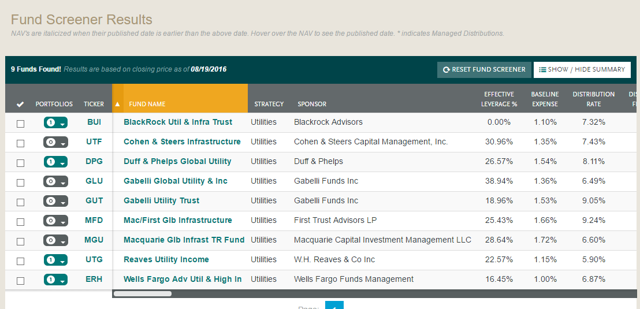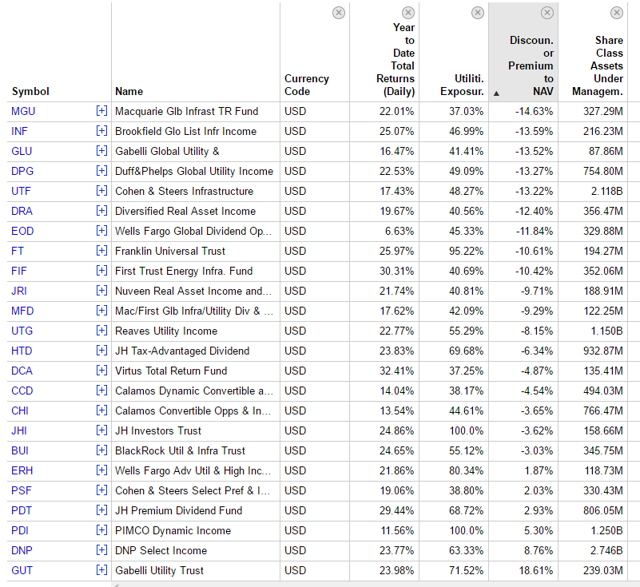5 Utility Closed End Funds You Can Still Buy At A Discount
In my last article, “BUI: Take Profits Off The Table,” I provided an update to one of our best performers year to date and our decision to now sell the fund.
As described I liked the BlackRock Utility&Infrastructure Trust (NYSE:BUI) because:
BUI is an investment in one of my favorite asset classes (utilities and infrastructure), utilizing one of my favorite investment strategies (covered call writing), in one of my favorite investment fund structures (closed end fund).
Source: BUI: Thrown Out With The Bathwater?
More importantly, BUI was trading at a significant discount to NAV when it was sold off late last year. Year to date, that discount nearly evaporated and the largest reason for the trade no longer existed.
When you look at the 13F filings for major institutions you would see that even as early as the 6/30 filing dates, institutions have been selling off the fund as well.
In the last article a number of our astute Unique Finance members asked about alternatives for BUI, so here are 5 closed end funds that have utility exposure that are STILL trading at worthy discounts.
The Methodology
Closed end funds are a special breed of investments, but I am sure you already know that. Unlike ETFs, open end mutual funds or evenbonds, there are few great resources available for closed end funds due dilligence. Perhaps the best source of closed end fund information that is available to both individuals and advisors is CEF Connect, sponsored by Nuveen Investments.
One of the tools that you will find on CEF Connect is the CEF screener. Amongst other criteria, the screener tool allows you to search for funds by investment category.
For our purposes, using the screener to find utility closed end funds generates only 9 names.

Source: CEF Connect Screener
Unfortunately by simply searching at the category level, we would miss many funds that would work for our purposes, simply because they are categorized or benchmarked to a different category.
What I did at this point was to then go and use some paid tools, such as YCharts.
Using the fund screener for US based closed end funds with at least 35% exposure to utilities we are able to generate 24 funds.

Source: YCharts Fund Screen
From those 24 I dug a little deeper into each one to narrow it down to a few names that popped.
5 Funds With Utility Exposure That You Can Still Buy At A Discount (Sorted by Discount to NAV)
- Cohen & Steers Infrastructure Fund (NYSE:UTF)
Trading at a 13.22% discount to NAV and distributing a 7.43% income only distribution makes this one of the best bargains in the space. Like other infrastructure funds, utilities make up a good portion, currently about 50% of the fund holdings. Things to keep in mind here, the distribution is quarterly, and not monthly like some other funds. Finally, at over $2 billion in assets, it is one of the larger closed end funds and unlike smaller funds, it may take UTF a little while longer to unwind a position.
- Nuveen Diversified Real Asset Income Fund (NYSE:DRA)
This closed end fund is a good alternative to investors that are currently in the Nuveen Real Asset Income Fund (MUTF:NRIAX). Trading at a discount to NAV of 12.40% and yielding a monthly income only distribution of 7.56% makes this one of my favorite funds. DRA is not a pure utilities fund but is a broader mandated fund seeking current income from real assets. As such, it invests across the capital stack of infrastructure and real estate companies. Utilities make up about 40% of the fund. Even though it is a newer fund, it has outperformed the category both over the last 1 year and since inception time periods.
- First Trust Energy Infrastructure Fund (NYSE:FIF)
FIF is primarily an equity only closed end fund with about 40% exposure to utilities. It is currently trading at a discount of 10.42% and yields a 7.35% distribution paid monthly. Even though it is primarily an income only fund, it has paid a bit of return of capital over the last few months. Unlike other infrastructure and utility funds, the discount to NAV has stayed fairly consistent over the last 3 years. With institutions accounting for about 25% of all shares and category beating 3 year and since inception numbers, FIF is worth a look.
- Nuveen Real Asset Income & Growth Fund (NYSE:JRI)
This fund is nearly identical to the Diversified Real Asset Income Fund, the primary difference is that JRI currently has a slightly higher equity exposure and it has been around a little longer. The discount here is also a little lower at 9.71% however the distribution is nearly identical at 7.55%. Like its sister fund, JRI has a good amount of institutional holders and is on my list. Performance has been great as it has beat its category over every measured time frame by CEF Connect, 3 month, 6 month, 1 year, 3 year and since inception time frames.
- Reaves Utility Income Fund (NYSEMKT:UTG)
UTG is a fund that I have not previously followed but it has currently peaked my interests. This fund currently yields 5.9% paid monthly, currently trading at a discount of 8.15% to NAV. It is a pure equity closed end fund that has been around for more than 12 years. With category beating performance over the 1, 3, 5 and 10 year numbers, it is also worth a look.
Bonus 5.5. John Hancock Tax Advantaged Dividend Income Fund (NYSE:HTD). So this is a closed end fund that is seeking tax advantaged long term capital gains and income that just happens to have more than 62% of its assets in Utility and Energy investments. The fund currently trades at a 6.34% discount to NAV and has a 5.88% distribution rate paid monthly. Unlike other closed end funds that we covered, HTD has no obligation to invest in utilities but is perhaps hiding out here for now? No guarantees that all of the utility exposure will not be sold off in the future. With a steady distribution which has been rising steadily since 2009 and consistent category beating performance, it would be prudent to take a look at HTD.
Our Take & Bottom Line
Even though I believe utilities may be towards their peaks, looking for an alternative to BUI has yielded 5.5 seemingly great alternatives.
Please note, these funds are those that passed the initial screen for what we are looking for and the first sniff test. Over the next week I will be taking a deeper look into all of these and will hopefully have a few candidates worthy of an allocation, which we will cover here in greater detail.
I hope this was helpful for you and gives you a few good ideas to put on your due diligence list.
Do you own any of these? What do you think?
Please feel free to reach out to me via direct message if you would like to chat more about this or any other topic.
Final Note: I hope you found this article helpful. I am a believer in active management that works and I am here to help you find those opportunities. Please follow me here on Unique Finance as we look for those opportunities and sort out the good managers from the mediocre.
Simply click the “Follow” button below if it appears for you, or click “Follow” next to my name at the top of the article. Alternatively, you can click the orange “Follow” button from my profile page.
THANK YOU for reading and commenting.
Disclosure: I/we have no positions in any stocks mentioned, and no plans to initiate any positions within the next 72 hours.
I wrote this article myself, and it expresses my own opinions. I am not receiving compensation for it (other than from Unique Finance). I have no business relationship with any company whose stock is mentioned in this article.
Additional disclosure: Maks Financial Services is a registered investment advisor and our Form ADV Part 2 is available upon request. We certify that the opinions and predictions in these articles are our professional beliefs at the time of publication and should not be construed as personal investment advice. Please consult your financial professional to see how anything discussed here applies to you. Furthermore this is not a solicitation to buy or sell any securities. This is not Tax Advice. Please consult your tax professional.